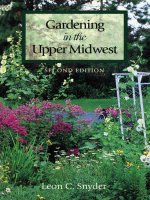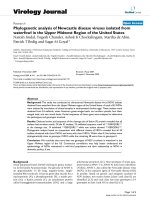gardening in the upper midwest 2nd edition jan 2000
Bạn đang xem bản rút gọn của tài liệu. Xem và tải ngay bản đầy đủ của tài liệu tại đây (15.65 MB, 321 trang )
Garckning
in the
Upper
/Midwest
This page intentionally left blank
Gardening
in
the
Second
Edition
LeonGSnyder
M
IN
NE
SO
TA
University
of
/Minnesota
Press/
/Minneapolis
Hi
Upper
yNAidwest
Copyright
©
1978,1985
by the
University
of
Minnesota
All
rights reserved.
No
part
of
this publication
may be
reproduced, stored
in a
retrieval
system,
or
transmitted,
in any
form
or by any
means, electronic, mechanical, photo-
copying,
recording,
or
otherwise, without prior written
permission
of the
publisher.
Published
by the
University
of
Minnesota Press
111
Third Avenue South, Suite
290,
Minneapolis,
MN
55401-2520
Printed
in the
United States
of
America
on
acid-free
paper
Second
edition,
Fifth
printing
2000
Library
of
Congress
Cataloging
in
Publication
Data
Snyder,
Leon
C.
(Leon
Carleton),
1908-
Gardening
in the
Upper
Midwest.
Includes
index.
1.
Gardening—Minnesota.
2.
Gardening—Middle
West.
I.
Title.
SB453.2.M6S59
1985 635.9'0977 85-1040
ISBN
0-8166-1428-8
ISBN
0-8166-3838-1
(pb)
The
University
of
Minnesota
is
an
equal-opportunity
educator
and
employer.
IV
I
his
book
is
dedicat
to my
wife,
Vera
A.
Snyder,
for
her
encouragement
and for her
tolerance
of
the
many hours spent
in
the
preparation
of
this manuscript.
V
T
Acknowledgments
The
author wishes
to
acknowledge
the
assistance
of and
thank
Helen
Bean, Nancy Roberts,
and
Mary Hartung, secretaries
at the
arboretum,
for
typing
the
manuscript; Linda Sanford, naturalist
at
the
arboretum,
for
drawing
the art
work;
June
Rogier,
librarian
at
the
arboretum,
for
helping with
the
index; Louis
and
Helen Fisher
of
Hastings
for
permitting
the
photographing
of
their yard,
and
the
Visual Aids Department
of the
Agricultural Extension Service,
the
Minnesota
State
Horticultural Society,
and
Michael Zins
for
providing color photographs.
Contents
Introduction
3
Chapter
1
Classification
of
Plants
7
Chapter
2
Plant Structure
and
Growth
12
Chapter
3 How
Plants
Are
Propagated
28
Chapter
4
Soil
and
Soil Improvement
40
Chapter
5
Plant Pests
and
Their Control
48
Chapter
6
Pruning
and
Training
54
Chapter
7
Home Fruit Growing
59
Chapter
8
Growing Vegetables
77
Chapter
9
Home Landscaping
96
Chapter
10 How to
Have
a
Good Lawn
101
Chapter
11
Selection
and
Care
of
Deciduous Trees
109
Plant Hardiness Zone
Map
112
Chapter
12
Selection
and
Care
of
Shrubs
139
Chapter
13
Selection
and
Care
of
Evergreens
173
Chapter
14
Selection
and
Care
of
Vines
183
Chapter
15
Selection
and
Care
of
Ground Covers
188
Chapter
16
Perennial Plants
for the
Sunny Flower Border
202
Chapter
17
Perennial Plants
for
Shady Gardens
230
Chapter
18
Garden Roses
248
Chapter
19
Bulbs
257
Chapter
20
Annual Flowers
266
Index
285
Color
photograph
section
follows
p. 152
Vll
This page intentionally left blank
Gardening
in the
Upper
/Midwest
This page intentionally left blank
Introduction
Many
excellent books have been written
on
gardening. Most
of the
authors
of
these books
are
from
the
eastern states,
the
South,
or
the
West
Coast.
George
Luxton's
Flower Growing
in the
North,
published
in
1956, dealt
only
with
flowers.
When
Gardening
in the
Upper
Midwest
appeared
in
1978,
it was the first
comprehensive
treatment
of
problems
faced
by
gardeners
in
this region.
The
sec-
ond
edition places greater emphasis
on
fruits
and
vegetables.
The
climate
of
Minnesota
and
surrounding states
and
Canada
is
different
from
that
in
other parts
of the
United States.
In the
winter,
the
temperature
can
drop
to
—
40°F.
or
colder.
In the
sum-
mer,
temperatures
can
climb
to
100°F.
or
higher.
Not
only
does
this area have extremes
of
temperature
but it
also
has a
fluctuating
rainfall.
Summer droughts
are not
uncommon. Generally,
the
rain-
fall
decreases
as one
moves
in a
northwesterly direction. Average
annual
rainfall
in our
area ranges
from
about
28
inches
in the
southeast
to
about
16
inches
in the
northwest. Fortunately, most
of
this rainfall comes during
the
growing season.
The
severity
of our
winters places
the
greatest limitation
on the
plants
that
can be
grown. Winter injury
on
plants takes many
forms:
3
4
Introduction
Tip
kill
and
dieback
on
woody
plants
may be the
result
of an
early
heavy
freeze
that
occurs before
plants
have fully
hardened,
thus
killing
the
late
growth.
Plants
must
be
selected
that
mature
earlier
in the
fall,
and
cultural practices must
be
modified
to
has-
ten
this maturity.
Lack
of
flower
bud
hardiness
is
another
problem with many
kinds
of
plants. Peaches, flowering quince,
and
many azaleas can-
not be
grown
successfully
here because they lack flower
bud
hardi-
ness. Breeding
to
develop hardier varieties
offers
the
best solution
to
this problem.
Winter
burn
on
evergreens
is
common.
We
have
all
seen yews
and
hemlocks turn
red and
brown
in
late winter.
The
plant hardi-
ness
laboratory
in the
Department
of
Horticultural Science
at the
University
of
Minnesota
has
shown that
one
cause
of
winter burn
is
a
sudden
drop
in
temperature.
The
sun, reflected from
a
white
snow surface
on a
still
day in
February,
may
cause
the
tempera-
ture
in the
leaves
to
rise
as
much
as 50° or
60°
F.
above
the air
tem-
perature.
If the sun
goes behind
a
cloud
or a
building,
the
tempera-
ture drops suddenly
and
tissues within
the
leaves
are
killed.
By
planting sensitive varieties
on
sites where they
will
receive some
winter shade,
the
problem
of
winter burn
can be
reduced. Another
practical approach
is to
plant species
and
cultivars (see
p. 9 for
definition)
that
are
naturally resistant
to
winter burn.
The
Universi-
ty of
Minnesota Landscape Arboretum
and
Horticultural Research
Center, both located
on
State Highway
5
west
of
Chanhassen,
are
evaluating thousands
of
species
and
cultivars
of
ornamental
plants
for
winter hardiness
and
landscape qualities such
as
texture,
fo-
liage,
color,
bloom,
and
resistance
to
insects
and
diseases.
We
have
identified
a
number
of
winter burn-resistance selections
in
ever-
green species that typically show v/inter burn.
Sunscald
on the
southwest side
of the
trunk
is
still another type
of
winter
injury
that occurs
on
thin-barked trees especially during
the
first
few
years until they have developed
a
crown that shades
the
trunk.
The
Norway maples
are
particularly sensitive
to
this
type
of
injury. Wrapping
the
trees
in the
fall
with
a
tree wrap
made
of
weather-resistant paper minimizes sunscald.
Soils
are
also
highly variable,
in
both
texture
and pH.
Heavy
clay soils
and
sandy soils
are
intermixed
in
certain areas.
In the
Introduction
5
same
yard
great
differences
in
soil
texture
may
exist.
The
gardener
should
understand
the
effect
of
soil
texture
on
soil moisture
and
plant
growth.
Some
plants
do
well
on
clay
soils,
others
on
sand.
In
northern parts
of the
area
it
would
be
unwise
to
attempt
to
grow
apples
on
sand because
of
problems
of
winter injury.
On
heavier
soils nearby, apples thrive.
The pH of the
soil
is
another important consideration. Iron
chlorosis,
a
yellowing
of the
foliage
caused
by a
lack
of
available
iron,
can be a
problem
on
alkaline soils, which
are
common
in the
Red
River Valley
and
throughout
the
western parts
of the
region.
Members
of the
rose
family
are
extremely susceptible
to
iron
chlorosis. Some plants, like ashes
and
lilacs, tolerate alkaline soils
and
these should
be
planted.
Few
soils
in the
region
are
extremely
acid. Adding lime
to
such soils corrects
any
acidity problem.
If
one
recognizes
the
limitations, gardening
in the
North
can
be a
rewarding experience. Some plants like peonies, lilacs,
and
flowering
crabapples grow
to
perfection.
We may
never have
a
cherry blossom festival like
that
held
in
Washington,
B.C.
each
spring,
but we can
have displays
of
flowering crabapples that
are
every
bit as
spectacular.
In
addition,
we
have
the
lovely
fruits
to
attract
birds
to our
yards during
the
winter. Fruit
and
vegetable
growing
can
also
be
rewarding experiences.
This book
is
written
to
help
new
gardeners
and
those
who may
have moved here from
a
milder climate.
It is
also hoped
that
ex-
perienced gardeners
may
find
information that will make them
even
better gardeners.
The
book
is
organized
to
give gardeners
a
ready reference
to
the
many gardening problems that arise.
The
first
6
chapters
are
devoted
to a
general discussion
of
plants
and how
they grow
and
to
cultural practices like soil management, pests
and
their control,
and the
pruning
and
training
of
plants. Chapters
7 and 8
cover
the
growing
of
fruits
and
vegetables
in the
home garden.
The
rest
of
the
book
is
devoted
to the
aesthetics
of
gardening, including land-
scape design,
the
lawn,
and the
selection
of
ornamental plants.
Lists
are
included
to
help gardeners select
the
right
plants
to
make
their yards more
beautiful
and
useful.
(Plants
are
listed alphabeti-
cally
by
scientific names, with common names
in
parentheses.)
There
are
chapters
on the
selection
and
care
of
deciduous trees,
6
Introduction
deciduous
shrubs, evergreens, vines, ground covers, perennial
and
annual
flowers,
bulbs,
and
garden roses. Ferns
are
included
in
Chapter
17.
A
hardiness zone map, keyed
to the
individual plants,
is
provided
in
Chapter
11,
p.
112.
The
information
in
this
book
is
based
on my
experience
as a
gardener,
my
teaching
and
administrative experience
at the
Uni-
versity
of
Minnesota
as
head
of the
Horticultural Science
and
Land-
scape
Architecture
Department,Superintendent
of the
Horticultural
Research Center,
and
director
of the
University
of
Minnesota
Landscape Arboretum.
I
have also answered thousands
of
garden-
ing
questions
in my
weekly gardening column
in the
Minneapolis
Star
and
Tribune
and on my
monthly
gardening program
on
WCCO
radio.
Chapter
i
Classification
of
Plants
Gardeners should have some knowledge
of how
plants
are
classi-
fied.
The
plant kingdom includes many kinds
of
plants ranging
in
size
from
microscopic bacteria
to
giant redwoods.
The
science
of
taxonomy deals with
the
orderly classification
of
these plants.
The
taxonomist
divides
plants into three major groups:
the
Thallophyta,
the
Bryophyta,
and the
Tracheophyta.
The
word
"Thallophyta"
means
"Thallus
plants."
These plants
are
primitive
and
undifferentiated
into roots, stems,
and
leaves.
The
bacteria,
fungi,
and
algae belong
to
this group. Bacteria
and
fungi
are
important
to the
gardener because they cause many dis-
eases
of
garden plants. Algae
are
sometimes
a
problem
in
green-
houses
and in
wet, shady locations.
The
word
"Bryophyta"
means
"moss
plants."
This group con-
tains
the
mosses
and the
liverworts. Mosses
are
primitive plants
that
like shade
and
moist sites. Liverworts
are
flat,
creeping plants
that
grow
in
moist, shady sites. They
are
frequently found growing
along
a
stream.
In
Japan
mosses
are
grown
for
their landscape
ef-
fect.
In the
moist Japanese climate mosses make
a
fine
ground cov-
er
under pines.
We use
mosses
in
terrariums,
but for the
most part
we
make little
use of
these charming plants
in
outdoor gardens.
When
mosses grow
in a
shady lawn,
we try to get rid of
them.
7
8
Classification
of
Plants
The
Tracheophyta have well-differentiated roots, stems,
and
leaves
and
well-developed tissues
for
conducting food
and
water.
The
group contains
the
ferns
and
their allies
as
well
as the
seed-
producing plants. This group
of
higher plants
is the one
that
the
gardener
is
primarily concerned with.
The
Tracheophyta
are
sub-
divided
into three classes: Filicinae, Gymnospermae,
and
Angio-
spermae.
The
Filicinae include
the
ferns
and the
fern allies like
the
horsetails
and
lycopodiums,
or
ground pines. These reproduce
by
spores
and do not
bear seeds.
The
Gymnospermae
and the
Angiospermae
are the
seed plants
and are
considered
the
highest
forms
of the
plant kingdom.
The
Gymnospermae include
the
conifers, cycads, ginkgoes,
and so on.
The
word "Gymnospermae" means
"naked
seed."
In
this group
the
seeds
are not
enclosed
in a
fruit.
In the
conifers
the
seeds
are
borne
at the
base
of the
scales that constitute
the
cones.
As the
cones mature,
the
scales separate
and the
seeds drop
to the
ground.
In the
Angiospermae
the
seeds
are
produced inside
fruits
which
assume
a
variety
of
forms
and may be
either
dry or
fleshy.
The
Angiospermae
are
divided
into
two
subclasses:
Monocotyledoneae
(monocots)
and
Dicotyledoneae (dicots). These names refer
to the
number
of
seed leaves,
or
cotyledons.
The
Monocotyledoneae have
other distinguishing characteristics besides
the
single
cotyledon:
The
leaves
are
parallel veined.
The
vascular bundles (water
and
food
conducting tissues)
are
often scattered
as in
corn,
and
there
is
no
well-differentiated cambium
(a
single layer
of
cells capable
of
cell division.
The
flower parts (sepals, petals, stamens,
and
car-
pels)
usually occur
in 3's or
multiples
of 3. The
Dicotyledoneae
is
the
largest group
of
seed plants.
In
addition
to
having
two
cotyle-
dons,
or
seed leaves,
the
leaves
are
netted veined,
the
vascular bun-
dles form
a
cylinder
and
develop
a
well-defined cambium,
and the
flower
parts
do not
occur
in 3's or
multiples
of 3.
Below
the
class
and
subclass categories, plants
are
classified into
orders
and
families
and
finally
into
the
correct
genus
and
species.
It is
important that
the
gardener know
both
the
scientific
and
common name
of a
plant. Knowing
the
family
to
which
a
plant
be-
longs
can
also help since many
of the
plants
in a
family
have
simi-
lar
cultural requirements.
The
scientific name always consists
of the
genus
and the
species
Classification
of
Plants
9
names
and
sometimes
the
name
of the
botanical variety.
The
com-
mon
name
may be
easier
for
some people
to
remember, but,
un-
fortunately,
different
common names
are
used
for the
same plant
in
different
parts
of the
country
and
occasionally
in the
same
lo-
cality.
For
example,
the
several species
of
Amelanchier
are
various-
ly
known
as
serviceberry,
sarvisberry, Juneberry, saskatoon, shad-
bush, snowy mespilus,
and so on.
The
scientific
name
for a
given plant, once
the
taxonomists have
agreed
upon
it, is the
same
throughout
the
world.
Scientific
names
are
not
difficult
to
pronounce
and are
easy
to
remember.
We
have
no
trouble remembering names like petunia, zinnia, tradescantia,
and
impatiens, which
are
generic names that
are
also used
as
com-
mon
names.
Every
plant
has a
genus
and
species identification. This system
of
classification
was
devised
by
Linnaeus
in the
eighteenth century
and is
called
the
binomial system.
Let us
take
a
familiar
group
of
plants like
the
maples.
All
maples belong
to the
genus
Acer.
The
species
name
is
often descriptive:
Acer
rubrurn
is the red or
swamp
maple,
Acer
saccharum
the
sugar maple.
In the
oaks
the
genus
name
is
Quercus.
Quercus alba
is the
white oak, Quercus coccinea
the
scarlet oak.
Minor
differences
in
plant
form
or
color
are
common within
a
plant species.
A
naturally occurring population
that
differs
from
the
species
is
called
a
botanical
variety.
An
example
is the
Black
Hills
strain
of
white spruce. Native across
the
northern United
States
and
Canada, white spruce have denser
foliage
in the
Black
Hills
of
South Dakota than elsewhere.
The
scientific
name
of the
white spruce
is
Picea
glauca.
The
strain growing
in the
Black Hills
is
Picea glauca var.
densata.
Another example
of a
botanical
vari-
ety is the
Colorado blue spruce.
The
Colorado spruce
is
normally
green,
but
occasionally trees with
a
bluish cast
are
found
in
nature
and in
nurseries.
The
scientific name
of
Colorado blue spruce
is
Picea
pungens
var.
glauca.
To
distinguish
a
horticultural variety from
a
botanical
variety,
the
term
"cultivar"
is
used.
A
single plant
in a
seedling population
may
differ
from
all the
rest.
If
this plant
has
characteristics
that
would make
it a
desirable plant
to
grow
for
ornamental
or
food
purposes,
it is
given
a
cultivar name
and
usually propagated
vege-
10
Classification
of
Plants
tatively
either
from
cuttings
or by
grafting (see Chapter
3). A few
examples will help
clarify
the
difference between
a
botanical vari-
ety and a
cultivar.
Let us
first
consider Picea
pungens
var. glauca
(Colorado blue spruce).
In a
seedling population containing blue
forms,
a
single plant
may be
distinct
in
form
or
color.
This
plant
can be
selected, propagated vegetatively,
and
introduced
as a
named cultivar.
A
cultivar name
is
always capitalized
and
either
enclosed within single
quotation
marks
or
prefixed with
the
letters
"CV."
The
Moerheim
Spruce
is a
compact form
of
Colorado blue
spruce
that
has
very blue foliage. This
is
properly designated Picea
pungens
'Moerheimi'
or
Picea
pungens
CV
Moerheimi. Several
seedlings
of
Norway maple develop
a
bloodred foliage.
One of
these
is the
Crimson King Norway maple. This
is
properly
desig-
nated
Acer
platanoides
'Crimson
King'.
Most cultivars
of
trees
and
shrubs
are
increased
from
a
single, selected parent plant
by
vege-
tative
means.
In
efforts
to
create
new and
better horticultural plants,
man has
often
crossed
two or
more species
of the
same genus.
The
seedling
population
from
a
cross between
two
species
is
sometimes given
a
specific
name.
To
distinguish this interspecific hybrid
from
a
natu-
ral species, the species designation is preceded by an "x." Spiraea
x bumalda (Bumalda spirea) is a hybrid species derived by crossing
S. japonica x S. albiflora; Syringa x chinensis (Chinese Lilac) by
crossing
S.
laciniata
x S.
vulgaris.
Of the
hundreds
of
other hybrid
species
that exist, some
are
natural hybrids
and
others were creat-
ed by
man. Usually,
a
seedling
population
of a
hybrid species
is
somewhat variable. Individual plants that stand
out as
being
su-
perior
to
their sister seedlings
may be
vegetatively propagated
and
given a cultivar name. Spiraea x bumalda 'Anthony Waterer' (An-
thony
Waterer
Spirea)
is
such
a
cultivar.
In the
development
of new
cultivars
in
many genera
of
plants,
several
species
are
sometimes involved
in the
ancestry
of a
single
selection. This
is
true with garden roses
and
many flowering crab-
apples.
In
such instances only
the
genus name precedes
the
cultivar
name. Mains 'Sparkler' is the proper designation for the recently
introduced Sparkler crabapple. Rosa 'Peace' is the proper designa-
tion
for the
Peace rose,
one of the
Hybrid
Tea
roses.
Not all
cultivars
are
vegetatively propagated. Some
are
grown
Classification
of
Plants
11
from
seed. This
is
particularly true
of
annual flowers
and
vegeta-
bles.
F!
hybrid seed
is the
result
of
crossing
two
inbred lines.
The
seedlings resulting
from
such
a
cross will
be
very uniform
and
are
given
a
cultivar name. Seeds saved
from
such hybrid plants will
not
produce
uniform plants; seedlings
in the
second generation
will
revert
to
parental types. This
is why one
should
not
save seeds
from
Fj
hybrids.
Cultivar
names
are
also
given
to
plants grown
from
open-polli-
nated
seeds, provided
the
resulting seedlings
are
uniform
and
dis-
tinctive.
Such seeds
are
generally
the
result
of
several generations
of
inbreeding
to fix the
desired characteristics. Seeds must
then
be
produced
in
isolated
fields
to
prevent cross-pollination
from
some
other cultivar.
With
commonly grown plants like
the
tomato
and
marigold,
it is
permissible
to use the
common rather than
the
scientific
name.
Tomato
'Big
Boy'
is as
acceptable
as
Lycopersicum
'Big
Boy'.
In
the
chapters
that
follow, many species
and
cultivar names
will
be
used;
the
preceding explanation should help gardeners understand
the
nomenclature.
Chapter
i
Plant
Structure
and
Growth
A
knowledge
of the
structure
and
growth
of
plants
is an aid to un-
derstanding
some
of the
problems that develop when growing
plants.
All
seed-producing plants have vegetative organs (roots,
stems,
and
leaves)
and
reproductive organs (flowers,
fruits,
and
seeds).
Ferns have vegetative organs
and
reproduce
by
spores.
Vegetative Organs
ROOTS
Roots anchor
the
plants. They also absorb water
and
plant
nu-
trients
from
the
soil
and
carry these upward
to the
stem. Some
roots
are
modified
for
food storage. Carrots, peonies,
and
rhubarb
are
familiar
examples. Although most roots grow under
the
surface
of
the
soil,
aerial roots develop
on
some plants, most often
on
those that grow
in
tropical rain forests.
The
form
of the
root
sys-
tem can
vary greatly.
A
plant
is
said
to
have
a
taproot when
a
sin-
gle
root
grows straight down
and
lateral
roots
develop from this
main root.
The
taproot
may or may not
serve
the
additional
func-
tion
of
food storage. Taproots modified
for
food storage
as in the
carrot
and
beet
are
called fleshy
taproots.
Some plants develop
12
13
fascicled
roots, with many roots
of
about
the
same size radiating
from
the
base
of the
plant.
In
most plants these
fascicled
roots
are
slender
and are
referred
to as
fibrous
roots. Such members
of the
grass
family
as
corn have
a
fibrous,
fascicled
root system.
In
other
plants, like dahlias
and
peonies,
the
fascicled roots
are
modified
for
food storage
and the
main roots
are
fleshy.
STEMS
Most
stems develop above ground
and are
variously branched.
The
functions
of the
stem
are to
support
the
leaves
in
such
a
man-
ner
that
they
are
exposed
to the
maximum amount
of
sunlight
and
to
transport water
and
minerals upward
to the
leaves
and the
manufactured
foods downward from
the
leaves
to the
roots.
Food
storage
is
another function
of
certain stems. Other stems develop
underground.
The
rhizome
of
quack grass
is a
creeping, under-
ground stem.
The
fleshy
rhizome
of the
iris
plant develops
at the
ground surface
and may be
partly below ground.
The
edible tuber
of
the
Irish
potato
is a
fleshy
stem that develops underground
at
the end of a
slender rhizome.
In the
gladiolus,
the
corm
is a
modi-
fied
fleshy stem.
In the
lily
and
onion, food
is
stored
in
bulbs con-
sisting
of a
conical stem
and
fleshy
leaf
bases.
The
fleshy
stems
of
the
cactus
are
green
and
carry
on
photosynthesis,
or
food manu-
facture.
LEAVES
Leaves
are
generally flat
and
green.
They
may be
rather
small
and
scalelike
in
some plants,
as in the
arborvitae,
or
needlelike,
as
in
the
pines.
The
major function
of
leaves
is
photosynthesis. Some
leaves
are
modified
for
food storage,
and the
scales
of the
lily bulb
are
modified leaf bases.
Leaves
assume
a
variety
of
forms. These leaf forms
and the ar-
rangement
of
leaves
on the
plant
can be
very useful
in
identifying
plants. Leaves
are
opposite when
two
leaves arise opposite each
other
on the
stem, alternate when only
one
leaf
develops
at a
node,
and
whorled when
three
or
more leaves arise
at a
node.
The
blade
of a
simple leaf
is in one
piece.
In
compound leaves
the
leaf
blade
is
divided into
a
number
of
leaflets. Normally,
a
leaf
has a
Plant Structure and Growth
14
Plant Structure
and
Growth
Diagram
of a
plant:
a.
leaf,
b.
stem,
c.
root.
Types
of
root
systems:
a. fleshy
fascicled,
b.
fibrous fascicled,
c.
fibrous
taproot,
d. fleshy
taproot.
Plant Structure
and
Growth
15
Modified
stems:
a.
rhizome
(iris),
b.
rhizome (quack grass),
c.
corm
(gladiolus),
d.
tuber
(potato),
e.
bulb
(onion),/,
bulb
(lily).
petiole that supports
the
leaf blade.
In
some plants there
are two
bractlike stipules
at the
base
of the
petiole.
The
venation
of
leaves
is
either parallel
or
netted. Parallel vena-
tion
is
characteristic
of
most monocots; netted venation,
of
most
dicots.
A
simple, netted-veined leaf
has
either
a
single midrib
from
which
lateral
veins radiate (pinnate venation)
or
several veins
of
about equal
size
radiating
from
the
base
of the
blade (palmate
venation).
The elm and the
maple respectively illustrate these
two
types
of
venation.
A
compound
leaf
may be
pinnately compound
(as
in the
green ash), twice pinnately compound
(as in the
Ken-
tucky
coffee
tree),
or
palmately
compound
(as in the
Ohio buck-
eye and
Virginia creeper).
There
are
several kinds
of
leaf margins.
An
entire leaf margin
has
no
indentations
and is
straight
or
curved.
A
jagged leaf margin
with
teeth
that
point outward
is
dentate.
If the
teeth point for-
16
Plant Structure
and
Growth
Types of leaves: a. pinnately compound, b. scale, c. needle, d. pin-
nately simple, e. simple, parallel veined, /. twice pinnately com-
pound, g. palmately simple, h. palmately compoun
ward,
the
margin
is
serrate.
A
scalloped margin with rounded teeth
is
crenate. Leaves
can
also have
different
kinds
of
lobes.
The oak
leaf
is
pinnately
lobed,
the
maple
leaf
palmately
lobed.
Reproductive Organs
FLOWERS
The
typical
flower
is
composed
of
modified
leaves
(sepals,
pet-
als,
stamens,
and
carpels) attached
to a
swollen stem tip,
or
recep-
tacle:









